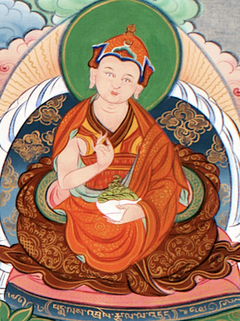Yoga of Fruition
The Yoga of Fruition
from the Four Yogas of the Khandro Nyingtik
Homage to glorious Samantabhadra!
There are six aspects to the regular application of the fruition: (1) the essence of fruition, (2) the manner or method of the fruition’s ripening, (3) the definition [of fruition], (4) its subdivisions, (5) the method of practice, and (6) the name for such fruition.
1. Essence
The essence of fruition is the attainment of a secure state from which there can be no regression. By gaining stability in the ultimate essence, beyond delusion, the fruition ripens and there is no reverting to the causal stage. This is compared to fruit that is ravaged by frost or the fruit of a sé tree.[1] A tantra says:
What we call fruition means capturing a stronghold,
Just like a king who takes the throne.
It is unchanging and irrevertible.
2. Manner
The manner in which the fruition ripens is that stability is achieved, such that it is impervious to circumstances.[2] A tantra says:
The way that fruition ripens is as follows:
Impervious to circumstances and irreversibly.
3. Definition
Fruition is defined as what results from the full maturation of the path. A tantra says, "Through ripening, there is the so called fruition."
4. Subdivisions
There are two types of fruition: provisional and ultimate. Provisional fruits are those that ripen as common [attainments] while practising the path. The ultimate fruition is the natural, spontaneous liberation—like a snake uncoiling its own knots—of karma associated with body, speech and mind, together with habitual tendencies, mental afflictions (kleśa) and all misdeeds and obscurations. A tantra says:
The fruition is divided into two:
The provisional and the ultimate.
5. Methods of Practice
The method of putting this into practice is to rest in a state in which all that manifests and appears is experienced as pure awareness (rigpa). This will swiftly bring stability. The Mirror of Vajrasattva’s Heart Tantra says, "Understand that all the qualities of fruition do not regress from the three kāyas."
6. Name
When applying a name to such results, we can call them utterly pure, spontaneous fruition. Why so? When what arises authentically in a continuum is stabilized and matured, it is called a fruition. The Word-Transcending Tantra says:
Although the fruition is inexpressible,
When reaching the exhaustion of phenomena,
One’s own philosophical system collapses.
At such a time, the guru’s instructions fade.
View, meditation and conduct are transcended.
There is no appearance of the dharmakāya.[3]
Since the kāyas and pristine wisdoms cease,
There are neither buddhas nor sentient beings.
In short, nothing whatsoever remains.
As nothing departs, nothing comes into being.
This was the regular yoga of the fruition.
These four yogas to be taken as the path
From the heart essence of secret mantra
Are hereby entrusted to you, Yeshe Tsogyal.
May they meet with the destined one!
Samaya. Gya. Gya. Gya.
This concludes the instruction on the four yogas.
| Translated by Adam Pearcey with the generous support of the Tsadra Foundation, 2025.
Bibliography
Tibetan Editions
"thun bzhi’i rnal 'byor las/ 'bras bu’i rnal 'byor" In snying thig ya bzhi. 13 vols. Delhi: Sherab Gyaltsen Lama, 1975. Vol. 10: 526–529 (2 folios)
Version: 1.0-20250213
